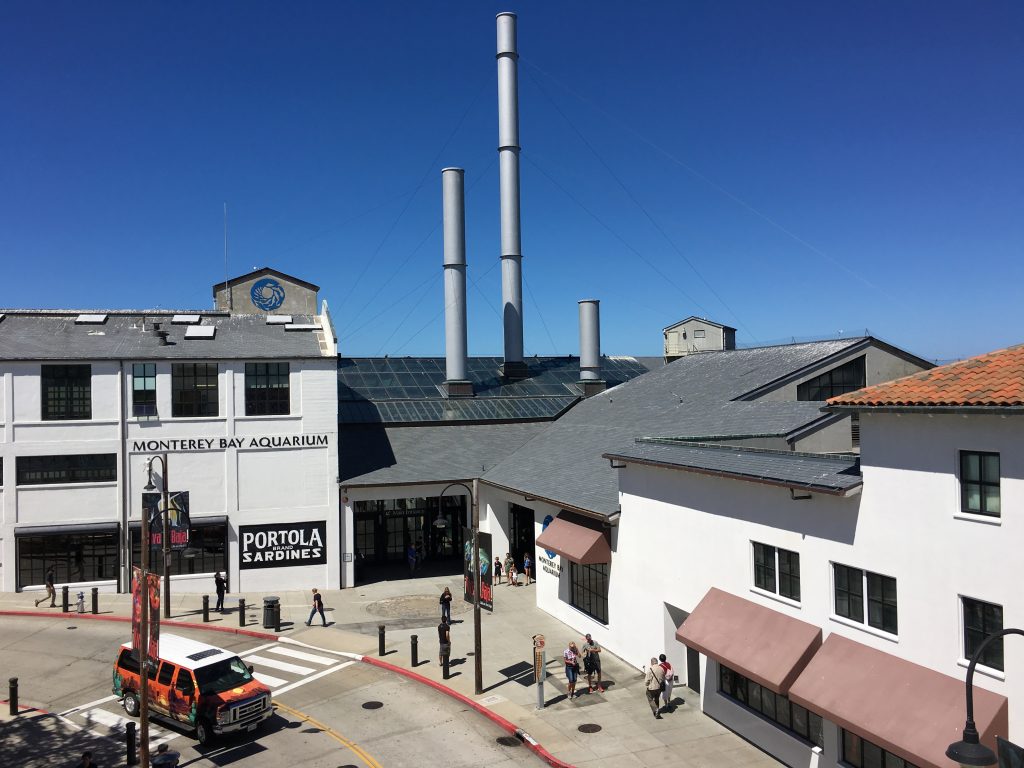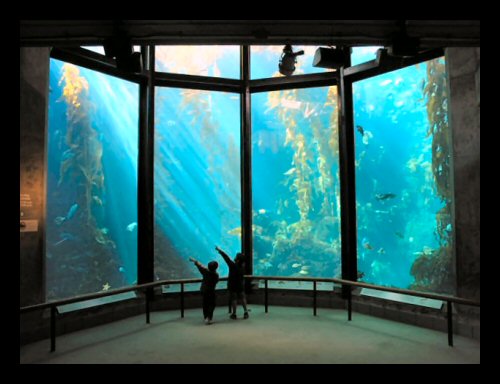Here at the blog we have a long-running infatuation with the Monterey Bay Aquarium in northern California and try to visit as often as possible, both in person and in the blog, and have written about the place before. When Fraser suggested re-visiting it, we quickly said yes. – Carl Kruse
by Fraser Hibbitt for the Carl Kruse Blog
“The Fish are back!” The irony was capitalized upon. A large cannery gone bust due to over fishing was now home to an aquarium. It may have been tempting to destroy the old image, but the architects decided to reclaim the fish by using that icon of excess. The repurposed aquarium is a perfect concrete symbol of re-fashioning unfettered industry into conscientious sustainability. Where the cannery once overlooked the shore in a kind of miserly contempt, the aquarium sought to amend the one-sided relationship, merging the shoreline with its structure. A ‘hodgepodge of roofs’, as one architect called it, now overlooks the Monterey Bay with a large balcony area for that extensive view – one that is contemplative rather than confrontational.
Entrance to the great Monterey Bay Aquarium.
Twenty-eight feet under the surface of the sea, meticulously kept and nurtured, the Kelp Forest, anything but idle, sways in the artificial surges created by the aquarium. Home to the variety of fishes that live in Monterey Bay. Regarded as one of the focal points of the aquarium, the Kelp Forest has defied expectation. Initial criticism during the planning stages ranged from doubt over whether a Kelp Forest could be kept under artificial conditions, to objecting that the public ‘probably wouldn’t be interested’. The otherworldly quality of this exhibition is something to marvel at – the mere descent is powerful enough to alter any mood, but now to gaze up at the plethora of life between the towering Kelp and the sun beams playing at the top of the canopy.
An astonishing feat, but what is equally important is that the Kelp Forest is a native of Monterey Bay. The aquarium is proud to promote their exhibits as part of the heritage of the Bay area. It is one of the founding principles of the enterprise: to exhibit marine life of the region. This was a rare quality in the 1980s, the tentative beginnings. Displaying local marine life is an attempt to, not only educate, but to register local residents with a more fulfilling connection to their area. The chance to be in communion with the host under the sea has changed assumptions about how to promote a city. The effect of the aquarium is perhaps most visible on the street it inhabits, Cannery Row. Once in decline, Cannery Row has now been revitalized due to the economic uplift fostered by the aquarium – spilling out in land, as well as out, to re-shape and conserve.
The presence of the aquarium has made itself felt outside of Monterey as well – as a place for research, and as a conductor of raising awareness around oceanic sustainability. Staff scientists have been able to safely observe and monitor marine life in an intimate way, producing a large body of published articles for the scientific community. Oceanic sustainability is, also, tied closely to the scientific work done at the aquarium. In keeping in line with ‘the fish are back’, the aquarium has worked with numerous charities to educate the public on sustainability issues facing us today, such as plastic pollution and causes of declination in certain marine species. The aquarium preserves this image by the rehabilitation programs they have conducted since the late twentieth century – harboring sea otters, western snowy plovers, and managing bluefin Tuna.
The Monterey Bay Aquarium has come to be viewed more as a waystation. Once rehabilitation, or the study, is complete, they let sea life go back into the wild – as was the case with the bluefin Tuna which were tagged on the way out. The place becomes more of passing through for some species – just as the viewers come and go, free to return to what they know. The aquarium also has something to say about where the fish end up, the fisheries. They routinely carry out checks upon fisheries to register their level of sustainability. They call it the Seafood Watch and its sphere of influence has only increased since its inception in the 90s – reaching out through mobile apps, and developing partnerships with local and nationwide grocers.
The details are all very impressive – and I have not even mentioned their political affiliations which are concerned with oceanic pollution and sustainability. However, there is something else about the aquarium: if we go back inside and follow the signs, we come across the largest exhibition of jellyfish in the world. These strange, hypnotic creatures pulsate through one of the largest tanks in the aquarium. I recall, when I was quite young, going down to a small harbor and finding the port to be filled inch-to-inch with these golden red blobs floating upon the surface, rocking back and forth. Hours later, when I returned, they had departed back out into the currents of the sea. This subtle life-form, seemingly mindless, always posed a kind of befuddling mystery.
This disparate but charming thought appeared to me as I watched the live cam that the Monterey Bay Aquarium posts online for their viewers. The jellyfish of the aquarium are captivating, mysterious. Of course, not a secret to the scientists who work to propagate the jellyfish, nor to us all who know the facts. All this, however, does not seem to be relevant when you look at the things slowly propelling by. Subtle life-force; propagated or not, the jellyfish takes on the currents of the sea, and it is the sea we think about watching these jellyfish. The sea’s opacity and depth may be a ready symbol for that mystery, the unconscious mind, but it is also something, the aquarium reminds us, that we can relate to, that we can take into consideration. Seeing the dilapidated sight of the old cannery, the Monterey Bay Aquarium thought only of its connection with the sea – the rest was ready-made material for conversion, fit to bring viewers closer to the mysteriousness of the ocean, where silent life now has an appreciative spectator.
============
The homepage for this Carl Kruse blog.
Contact: carl AT carlkruse DOT com
Other articles by Fraser Hibbitt include Van Der Kolk and the Story of Trauma, Stoicism and A Conversation Between Oakley and Eagerton.
The blog’s last post was on Lost Architeecture.



Love me some Monterey Bay Aquarium.
This place looks fantastic!
One of my go-to things to relax is the Jellyfish cam at the Monterey Bay Aquarium. Just a few minutes taking in these beautiful creatures is enough to relax me.
https://www.montereybayaquarium.org/animals/live-cams/jelly-cam
Love it. I have the DVD made years ago by Ambience Visuals called “Jellies,” which features the jellyfish of the Monterey Bay Aquarium, and it is one of my favorite “background” videos ever.
https://www.swapadvd.com/Art-Nature-Jellies-Jellyfish-Aquarium/dvd/192840/
Carl Kruse